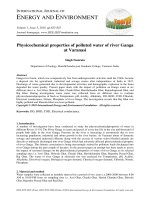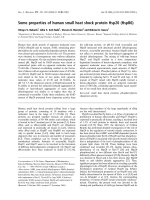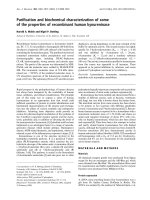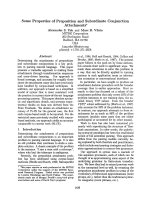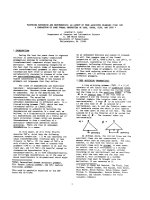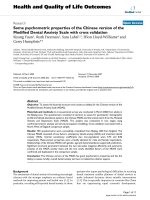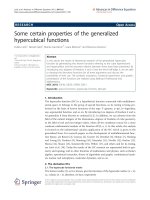Some physicochemical properties of jackfruit
Bạn đang xem bản rút gọn của tài liệu. Xem và tải ngay bản đầy đủ của tài liệu tại đây (141.43 KB, 5 trang )
ScienceAsia 28 (2002) : 37-41
Some Physicochemical Properties of Jackfruit
(Artocarpus heterophyllus Lam) Seed Flour and Starch
Vanna Tulyathana, *, Kanitha Tananuwonga, Prapa Songjinda and Nongnuj Jaiboonb
a
Department of Food Technology, Faculty of Science, Chulalongkorn University, Thailand 10330.
Department of Chemistry, Faculty of Science, Chulalongkorn University, Thailand 10330.
* Corresponding author, E-mail: ,ac.th
b
Received 11 Jan 2001
Accepted 29 Aug 2001
ABSTRACT Some physicochemical and rheological properties of jackfruit seed flour and starch, isolated
from the flour were investigated. The flour had good capacities for water absorption (205%) and oil
absorption (93%). Substitution of wheat flour with the seed flour, at the level of 5, 10 and 20% markedly
reduced the gluten strength of the mixed dough. The Brabender amylogram (6% concentration, db) of
seed starch showed that its pasting temperature was 81 °C and its viscosity was moderate, remained
constant during a heating cycle and retrograded slightly on cooling. The starch showed an A-typed X-ray
powder diffraction pattern.
KEYWORDS: Jackfruit Flour, Jackfruit Starch, physicochemical and rheological properties.
INTRODUCTION
Jackfruit (Artocarpus heterophyllus Lam) is
popular fruit crop that is widely grown in Thailand
and other tropical areas. The ripe fruit contains well
flavored yellow sweet bulbs and seeds (embedded
in the bulb). The edible bulbs of ripe jackfruit are
consumed fresh or processed into canned products.
Seeds make-up around 10 to 15% of the total fruit
weight and have high carbohydrate and protein
contents (Bobbio et al 1978 and Kumar et al 1988).
Seeds are normally discarded or steamed and eaten
as a snack or used in some local dishes. As fresh
seeds cannot kept for a long time, seed flour can be
an alternative product, which be used in some food
products.
There have been few studies on jackfruit seeds.
Bobbio et al (1978) reported some physicochemical
properties, such as pasting characteristics of jackfruit
seed starch. Kumar et al (1988) studied the proximate
compositions of two varieties of jackfruit seeds and
reported considerable biochemical difference between
the two varieties. The starch content of the seed increases with maturity (Rahman et al 1999). Different
locations give different seed contents. Some functional
properties of jackfruit seed flour and its protein
digestibility was reported by Singh et al (1991).
This work investigated some physicochemical
and rheological properties of the flour and the
isolated starch from a local jackfruit variety called
Thong – Sud – Jai. This variety is of local origin in
Prachinburi Province. It is widely grown in Thailand
and gives a high fruit yield (Yospunya, 1999). The
type of starch analyzed by the X-ray powder diffraction technique, the first reported use of this
technique to study jackfruit starch. Additionally,
bread dough substitution with jackfruit seed flour
was also investigated.
MATERIAL AND METHODS
Sample preparation
Jackfruit (Artocarpus heterophyllus Lam) variety
Thong Sud Jai seeds from a local market in Bangkok,
Thailand was used for this study. The seeds (3 kgs)
were cleaned and the white aril (seed coats) were
peeled off. Seeds were then devided into two parts.
One part was lye-peeled with 5% NaOH for 2 min to
remove the thin brown spermoderm covers the fleshy
white cotyledons. The seeds were sliced into thin
chips and tray dried at 50° - 60 °C until their moisture
content was less than 13%. The chips were ground
in a Pin mill FFC-23 to a 70 - mesh flour, packed in
plastic pouches and stored in a refrigerator (<5 °C)
until use. The yield of the flour was 36.4%
Starch isolation
Starch isolation from flour was carried out following the basic procedure washing steps suggested by
Bobbio et al (1978). The flour was mixed with 3
parts of distilled water and made into slurry. The
slurry was filtered through a 70 µm sieve to eliminate
seed fibers. The starch suspension was allowed to
settle and the liquid was decanted at < 10 °C. This
38
step was repeated several times until the supernatant
was clean and clear. The starch was dried in a
convection oven at 40 ° to 60 °C until the moisture
content was less than 13%, then ground with a
mortar and pestle and passed through a 70 µm sieve.
Sample was stored in air tight containers at room
temperature until use.
Chemical analyses.
Representative samples of flour were analyzed
in triplicate for moisture, crude protein (conversion
factor N x 5.7), crude lipid, and crude fiber ash
contents using standard methods of the Association
of Official Analytical Chemists (AOAC) (1990).
Total starch was measured following the polarimetric
procedure of Meloan and Pomeranz (1973).
The Specific rotation, [α] = 203, which is arbitrarily taken as value for all starch was used for
calculation (AOAC 1990). The pH of the flour was
measured by the potentiometric method following
the standard procedure in AOAC 1990.
Nitrogen content of jackfruit seed starch was
analyzed by a macro-Kjeldahl method (AOAC,
1990). Four grams of the starch was used for the
analysis. Protein content was calculated by multiplying
the nitrogen content by 5.7.
Amylose contents of jackfruit seed starch was
determined in triplicate using the spectrophotometric method described by Javis and Walker (1993).
Standard potato amylose and amylopectin (Sigma
Chemical) were used as references.
Physical and functional properties
Granular morphology of the isolated starch granules was identified in a light microscope. Scanning
Electron Microscopy analysis of the isolated starch
was performed in an SEM (JOEL Tokyo, Japan) with
magnification of 1100X.
X-ray diffraction: step-scanned X-ray powder
diffraction patterns for jackfruit starch were collected
on the finely ground samples on a Shimadzu 610
diffractometer (Shimadzu, Tokyo, Japan). The X-ray
source operated at 30 kV and 40 mA with a Cu target
and graphite – monochromator radiation Kα radiation (λ = 1.5406). Data were collected by stepscanned method between 2 ° to 60 ° in 2θ with a step
size of 0.02° 2θ and a counting time of 2 sec/step.
Water and oil absorption capacities of the flour
were measured in triplicates by the method of
Sosulski et al (1987), using 0.5 g flour (dry weight
basis, dwb) in 15 ml centrifuge tubes.
Brabender viscosity curves of flour and starch at
8% concentration (dwb) were determined according
ScienceAsia 28 (2002)
to the procedure described by Mazur et al (1957).
Standard procedures using the Brabender farinograph (Brabender OHG Duisburg, model 82575000)
and extensograph (Brabender OHG Duisburg, model
850000) were employed to determine the rheological
properties of the doughs.
White breads were prepared by a straight dough
method using the standard procedure in AACC
(1983). All purpose wheat flour (protein 10-11%)
were supplemented with three different levels (5,10,
20%) of jackfruit seed flour. Specific volume (cm3/
100gm) of the breads was determined by the seed
dis-placement method.
RESULT AND DISCUSSION
Flour
The flour composition of this study, compared
with Singh et al (1991) were shown in Table l. The
major components of the flours were carbohydrates
(78.0%). The proximate analysis showed that protein
(11.2%, dwb) and lipid (0.99%, dwb) contents of the
flour were lower than those reported by Singh
et al (1991). The difference can be contributed by
variety difference, maturation of the seeds and
environmental conditions. These effects were already
reported by Rahman et al (1999).
Composition of flour depends on nature of the
seeds. Bobbio et al (1978) reported protein, crude
lipids and carbohydrates contents of jackfruit seeds
as 31.9%, 1.3% and 66.2% (dwb), respectively. The
protein content reported by Bobbio et al was very
high; however, the seeds were reported to have been
collected from fruits of various trees and no variety
was reported. Kumar et al (1988) also reported
composition of seeds from two varieties of jackfruit.
Protein, crude lipids and carbohydrates content were
17.8-18.3%, 2.1-2.5% and 76.1% (dwb), respectively.
If the flour was prepared from seeds without
removing the thin brown spermodesm, the crude
fiber content was 2.36% (Table 1), close to that reported by Singh et al (1991). However, the flour used
in this study was prepared only from lye-peeled seeds
to remove the brown coating.
Water absorption capacity and oil absorption
capacity of the flour were reported in Table l. These
indicated good ability of the flour to bind water and
lipid. The water absorption in this study was higher
than that reported by Singh et al (1991). Milling
equipment and flour preparation methods, such as
a milling time can effect some properties of the flour;
for example, starch damage, which will result in high
water absorption because water can penetrate into
granules more easily than intact granules.
39
ScienceAsia 28 (2002)
Since the seed flour had high protein content
(11%), the possibility of substitution of wheat flour
with the seed flour for bread making was investigated. Table 2 showed the rheological tests of jackfruit
seed flour mixed with wheat flour. With increasing
level of supplementation, the water absorption
capacity increased. High water absorption capacity
is a characteristic of the wheat flour which is employed
for bread making (Kent, 1975). The bread dough
peak time and dough stability time were reduced as
supplementation increased. This confirmed the
reduction of protein gluten strength in the wheat/
seed flour. The mixed dough also showed a poor
mixing tolerance index (viscosity difference after 5
min of peak viscosity). With more supplementation,
the mixing tolerance index increased. Extensograph
also indicated that the dough had poor extensibility
and resistance to extensibility as compared to normal
wheat dough. As the results, the specific baking
volume of the bread was reduced by 51% at 5%
supplementation level of wheat flour with jackfruit
seed flour (Table 2).
Starch properties
Scanning electron microscopy (SEM) and optical
microscopy under normal light showed round and
bell-shaped granules predominate (Figure 1).
Optical microscopy with polarized light showed
sharp dark maltese cross in all starch granules. The
hilum is central (Figure 2). The birefringence is
different from that of the faint polarization cross
reported by Bobbio et al.
Pasting properties of 8% jack-fruit seed starch
was studied by means of the Brabender viscoamylograph (Table 3). Tapioca and corn starches, which
are commonly used in food industry, are also shown
Table 1. Composition and some physicochemical characteristics of jackfruit flour (% dry weight basis, except
moisture).
% (dwb)
Determination
With brown spermoderm
Without brown spermoderm
Singh et al (1991)
Moisture
7.70 ±0.20
8.57±0.25
5.1
Crude protein (%Nx5.7)
11.02±0.46
11.17±0.21
17.2
Crude lipid
1.01±0.12
0.99±0.08
2.2
Crude fiber
2.36±0.04
1.67±0.11
3.06
Ash
3.97±0.04
3.92±0.03
3.6
81.64
82.25
74
Total starch
77.76±0.96
-
Amylose content of starch
32.05±1.20
-
Total Carbohydrate (a)
Protein content of starch
1.84
-
pH
5.68
-
Water absorption capacity(%)
205
141
Oil absorption capacity (%)
92.6
90.2
(a)
determined by difference
Table 2. Rheological tests of flours and specific volumes of white bread.
Parameter
WF
JF 5%
JF 10%
JF 20%
WF 95%
WF 90%
WF 80%
66.9
% Water absorption
66.6
66.0
66.3
Arrival time (min)
1.7
1.7
2.0
1.7
Peak time (min)
8.6
4.9
4.7
3.4
Stability time (min)
11.4
6.8
5.3
4.1
51
100
118
178
13.3
Mixing tolerance index (BU)
Extensibility (cm)
9
11.1
9.9
Resistance extensibility (BU)
1000
740
523
185
Specific volume of bread cm3/100 gm
8.64
4.21
3.51
3.21
WF, wheat flour, JF, jackfruit seed flour ; BU, Brabender unit
40
ScienceAsia 28 (2002)
for comparison. The lower breakdown of viscosity
(P/F value) during heating cycle for jackfruit seed
starch as compared to that of tapioca starch indicated
good stability of the starch paste and good bonding
forces within the starch granules (Zobel et al, 1984).
The starch paste also showed lower retrogradation
as compared with tapioca and corn starch pastes.
Amylose content of jackfruit seed starch was 32%,
(Table 1), higher than the mean value found in
tapioca starch (17%) and corn starch (26%). However,
the starch paste showed relatively low retrogradation.
This is probably due to differences in amylose
molecular weight and its ability to leach out of the
starch granules (Zobel, 1984).
The jackfruit starch is in an amorphous state as
seen from the broad XRD peak pattern presented in
Figure 3. The XRD pattern of jackfruit is different
to the patterns of potato and water chestnut starch,
especially in position and relative peak intensity in
the range of 2θ = 5 °-6 °, but it is similar to the pattern
of waxy rice (Hizukuri, 1988). The absence of the
peak of 2θ = 5 °-6 ° is characteristic of type-A starch,
Therefore, the jackfruit seed starch belongs to A-type
starch as do cereal starches in general belong to the
A-type pattern (Zobel, 1964). Cheetham and Tao
Fig 1. Scanning electron micrograph (1100x) of jackfruit seed
(Artocarpus heterophyluss L) starch.
(1998) also reported waxy maize starch (amylose
0%) and maize starch (amylose 28%) showed a
typical A-type pattern. Transition from A-type to Btype pattern occurrs at amylose about 40%.
CONCLUSION
Flour from jackfruit seed was prepared by dry
milling. It is high in protein and carbohydrate
contents. The flour has good water and oil absorption abilities. However, less than 5% of wheat-flour
can be replaced with jackfruit seed flour for making
white bread. Further studies are required to improve
the seed flour quality for usage.
Starch was also isolated from the flour. Its
amylose content was high. The starch showed good
paste stability during heating and gave the A-type
X-ray diffraction pattern.
REFERENCES
1. AACC (1983) Approved Methods of the American Association
of Cereal Chemists. AACC. St Paul, Minn.
2. AOAC (1990) Official Methods of Analysis. 15th ed. Association
of Official Analytical Chemists. Washington, DC.
Fig 2. Photomicrograph of jackfruit seed starch under polarized
light.
Table 3. Pasting properties of jackfruit – seed tapioca and corn starches.
% (db)
Pasting properties
Jackfruit Starch 8%
Tapioca 8%
Corn 8%
Pasting temperature (°C)
81
61
73
Peak viscosity (BU)(a) (P)
798
1590
750
Final viscosity @ 95 °C 20 min (BU) (F)
680
400
700
Cooled to 50 °C (BU) ( C )
820
690
1350
Breakdown (P / F)
1.17
3.98
1.07
Retrogradation (C / F)
1.21
1.73
1.93
(a) (BU) = Brabender Unit
41
ScienceAsia 28 (2002)
smoothed data
2500
2250
counts /a.u.
2000
1750
1500
1250
1000
750
5
10
15
20
2 theta /deg.
25
30
35
Fig 3. X-ray powder diffraction pattern of jackfruit seed starch.
3. Bobbio FO, El-Dash AA, Bobbio PA and Rodrigues L R (1978)
Isolation and characterization of the physicochemical properties of the starch of jackfruit seeds (Artocarpus heterorphyllus).
Cereal Chem 55, 505-11.
4. Cheetham NWH and Tao L (1998) Variation in crystalline
type with amylose content in maize starch granules: an X-ray
powder diffraction study. Carbohydrate Polymers 36, 277-84.
5. Hizukuri S, Takeda Y, Shitaozono T, Abe J, Ohtakara A, Takeda
C, Saga C and Suzuki A (1988) Structure and properties of
water chestnut (Trapa natans L var bispinosa Makino) starch.
Starch/Starke, 40, 165-71.
6. Javis CE and Walker JRL (1993) Simultaneous, rapid,
spectrophotometric determination of total starch, amylose and
amylopectin. J Sci Food Agric 63, 53-7.
7. Kent HL (1975) Technology of Cereals 2nd ed Flour Milling and
Baking Association.
8. Kumar S, Singh AB, Abidi AB, Upadhyay RG and Singh A
(1988) Proximate composition of jack fruit seeds. J Food Sci
Techno 25, 308-9.
9. Mazurs E, Schoch TJ and Kite FE (1957) Graphical analysis
of the Brabender viscosity curves of various starches. Cereal
Chem 34, 141-52.
10.Meloan CF and Pomeranz Y (1973) Food Analysis Laboratory
Experiments. AVI Publishing Company, Inc, Westport,
Connecticut.
11.Rahman MA, Nahar N, Mian AJ and Mosihuzzaman M (1999)
Variation of carbohydrate composition of two forms of fruit
from jack tree (Artocarpus heterophyllus L) with maturity
and climatic conditions. Food Chem 65, 91-7.
12.Singh A, Kumar S and Singh IS (1991) Functional properties
of jack fruit seed flour. Lebensm – Will u Technol 24, 373-4.
13.Sosulski FW and McCurdy AR (1987) Functionality of flours,
protein fractions and isolates from peas and faba bean. J Food
Sci 52, 1010-4.
14.Pranichaya Y (1999) Kanoon 3rd ed, Matichon Pub Comp,
Bangkok, Thailand.
15.Zobel H F (1984) Gelatinization of Starch and Mechanical
Properties of Starch Pastes. In Starch: Chemistry and
Technology. (Edited by Whistler, R L, BeMiller J N and Paschall
E F ), pp 300-302. Academic Press, New York.
16.Zobel H F (1964) X-ray Analysis of Granular Starches. In
Methods in Carbohydrate Chemistry, Vol IV. (Edited by Whistler
R L, Smith R J, BeMiller J N and Wolform M L). pp 109-113,
Academic Press, New York.
